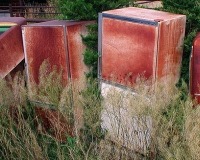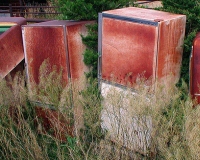How To Conserve Energy In The Kitchen
Ever wondered if washing dishes by hand saves water and energy over using the dishwasher? Or, should you replace the fridge from 1989, even though it's still running? We've got the inside information on keeping it efficient in the kitchen.
— Marisa McNatt, Earth911
A more efficient refrigerator
The fridge is the single biggest energy-consuming appliance in most households, according to the EPA. And the older it is, the higher its energy load.
On average, refrigerators bought before 1993 use twice the energy of Energy Star-qualified models and cost over $65 more to operate per year. Refrigerators bought before 1980 cost $200 more per year on average. Get an idea of how much it costs to operate your current fridge model. Use the Energy Star Refrigerator Retirement Savings Calculator and compare the operating cost of your current model compared to an Energy Star qualified model (Image: Flickr/ edcrowle)
If it's time to replace your fridge, make sure your old refrigerator gets recycled. There are more than 120 pounds of recyclable steel in the average refrigerator aged ten years or older. Recycling 120 pounds of steel saves an equivalent of almost 290 kilowatt-hours.
Quick tips for the fridge:
• Check the internal temperature of the refrigerator and freezer. The internal temperature of the fridge should be set between 36 and 42 degrees Fahrenheit and the freezer should be set at 3 degrees Fahrenheit. A small thermometer can be used to make sure the fridge and freezer aren't colder than necessary.
• Seal dishes stored in the fridge tightly. Moisture released from foods can make the refrigerator work harder to keep cool.
• Going away for four weeks or longer? It's generally recommended to unplug your fridge. However, Energy Star recommends contacting the manufacturer of your refrigerator model for detailed advice.
Try conservation cooking
What are the most energy efficient ovens and stove ranges? Ovens and stove ranges used in the home are not included in the Energy Star labeling program. However, homeowner cans find oven and stove ranges that are more efficient than others.
When buying a new oven and stove range "look beyond the initial price tag," suggests the California Energy Commission. You could have your oven for another 20 years, so the operating cost should also be considered.
Quick tips for ovens:
• Install your oven away from the refrigerator. Or, the oven's heat will make the refrigerator work harder. If the refrigerator and oven have to be installed next to each other, place a sheet of insulation foam between them.
• Consider a convection oven. On average, convection ovens use about one-third the energy of an electric oven. They distribute heat more evenly than ordinary ovens, so cooking time and cooking temperature can be reduced.
• Keep the oven door closed. The temperature in the oven can actually drop by 25 degrees each time you open the oven door. Trust your recipes, or make sure the oven light is working.
• Preheat the oven only when necessary. Only on steps three of the recipe, and the oven's already preheated? Your recipes may tell you to preheat the oven first thing, but don't preheat the oven until you have to. Also, unless you're baking breads, or pastries, you may not even have to preheat the oven.
• If you have a self-cleaning oven, take advantage of the remaining heat and clean the oven right after you use it. Check the seal on your oven door. Cracks and tears can allow heat to escape.
Quick tips for stove ranges:
• Go with gas cooking instead of electric. A gas stovetop with an electronic ignition costs half as much to operate as an electric stovetop, according to the California Energy Commission.
• Choose a pot the same diameter as the burner. If you choose the right size pot, you can save up to $36 annually using an electric range stove and $18 annually for a gas range stove. If you have a gas range, make sure to keep the burners clean. A blue flame means your gas range is working correctly. A yellow flame, however, may mean that the stove needs to be serviced to run more efficiently.
• Reduce the amount of heat your need. Use a pot that is the right size for the amount of food you're cooking, replace warped pots and pans that no longer distribute heat evenly and efficiently and put lids on pots.
Click to read the rest of the article and get more energy-saving tips for your kitchen.
More on Earth911:
• Earth911's Green Spring Cleaning Guide: Kitchen
• Scrap Wood Finds New Life in Contemporary Korean Kitchens
• Reduce Food Waste in 5 Easy Steps

